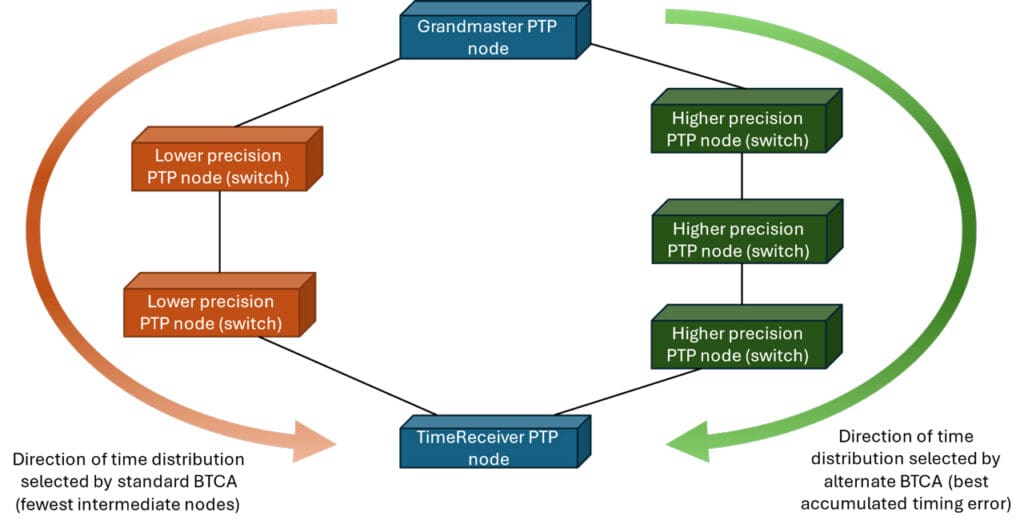Whether we’re aware of it or not, much of the technology that enables our modern world and lifestyle depends on time synchronization within communications networks. IEEE 1588™-2019, commonly known as the Precision Time Protocol (PTP), enables that synchronization. PTP allows accurate timing to be distributed from a single reference time source (called a Grandmaster) to time sync endpoints (called TimeReceivers) throughout a network so that everything works as it should.
Many industries and organizations rely on PTP, including telecom providers, industrial facilities, electric and autonomous vehicles, broadcast television networks, electrical distributors, financial networks, and even the Large Hadron Collider from the European Organization for Nuclear Research (CERN). This earlier Beyond Standards article details these use cases and how PTP helps drive them.
The IEEE 1588 Working Group is always working to make PTP even better. IEEE SA recently announced the passage of a new amendment to the standard: IEEE 1588a-2023.
This new amendment enables even more accuracy through the addition of receiver-side verification. This allows TimeReceivers to not only receive highly accurate timing from the Grandmaster, but also to report back to confirm that level of accuracy.
The amendment also provides the following improvements:
- It clarifies the operation of the Best TimeTransmitter Clock Algorithm (BTCA). The BTCA selects the reference time source for the network and determines the timing distribution paths.
- It expands the ability of PTP to gather information about timing errors introduced by the network.
- It explains how this expanded ability can be used to improve the BTCA.
The BTCA uses clock properties and network path information to select the reference time source of the network and to decide how timing information flows to the nodes that need it. The BTCA accomplishes this in a manner that uses little computational resources at each PTP node and minimal messaging. However, the BTCA is complex and not easy for network operators and system integrators to understand. So IEEE 1588a contains an informative Annex that clarifies the operation of the BTCA and provides an example that explains the decisions made by the BTCA of each PTP node in the example network.
PTP messages can be extended to include more information using type-length-value extensions (TLVs). A new TLV incorporated in the amendment supports enhanced accuracy metrics by providing information about the expected accuracy of distributed time over a PTP network by collecting timing information from the network’s PTP nodes. This information includes a count of the number of PTP nodes (e.g. Ethernet switches) that the PTP messages traverse to get to the TimeReceiver and the accumulated timing error contributed by these nodes. The IEEE 1588a amendment enables a more flexible configuration of this TLV.
The information from the new TLV allows the path with the best timing error rather than the path with the fewest intermediate PTP nodes to be selected by an alternate BTCA. An IEEE 1588a amendment annex explains how this alternate BTCA could operate. Such improvements are already under consideration in standards for telecommunication networks.

This amendment can help readers understand the basic operation of the BTCA and see how it can be enhanced by using the information from the new TLV. This can lead to improved PTP timing performance in existing, evolving, and new PTP networks. This amendment can be found at IEEE 1588a-2023.
Authors (listed by last names alphabetically):
- Doug Arnold, Meinberg
- Stephan Bedrosian, Mitre
- Rodney Cummings, Keysight
- Samer Darras, Microchip
- Liuyan Han, China Mobile
- Mikael Johansson, Ericsson
- Terry Jones, Oak Ridge National Laboratory
- Kang B. Lee, National Institute of Standards and Technology Retiree
- Maciej Lipinski, CERN
- Jingfei Lv, Huawei
- Silvana Rodrigues, Huawei
- Stefano Ruffini, Calnex Solutions
- Arshad Saleem, Ciena
- Kristof Teichel, Physikalioch Tachnisshe Bundesanatali National ManolourInstitute
- Richard Tse, Microchip Technology
- Max Turner, Ethernovia








